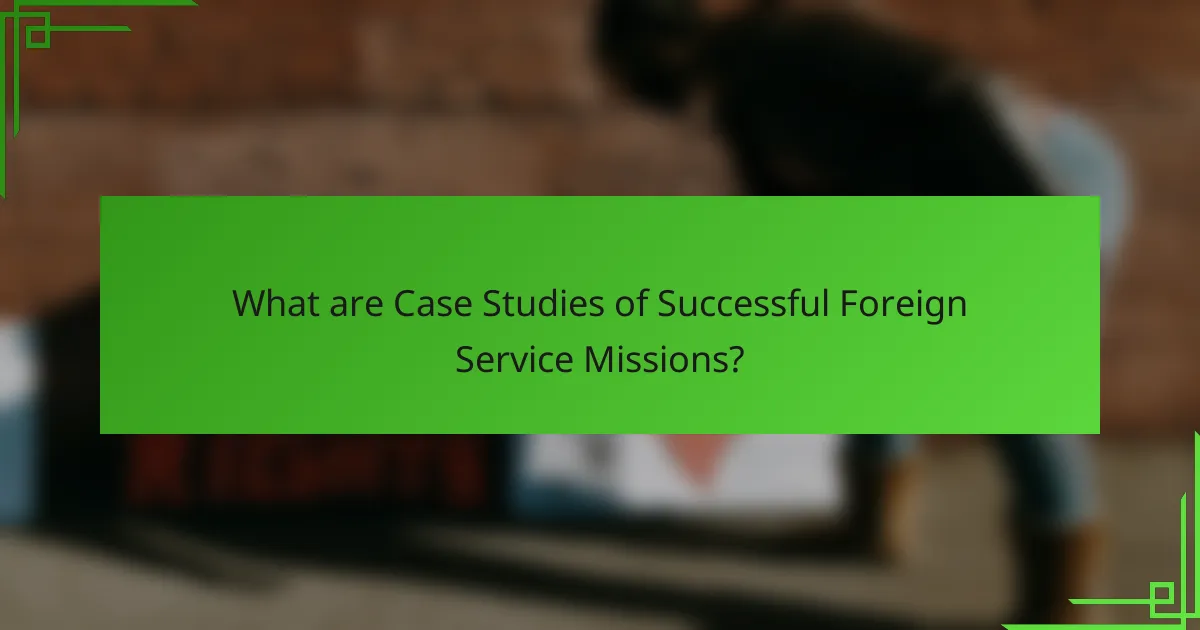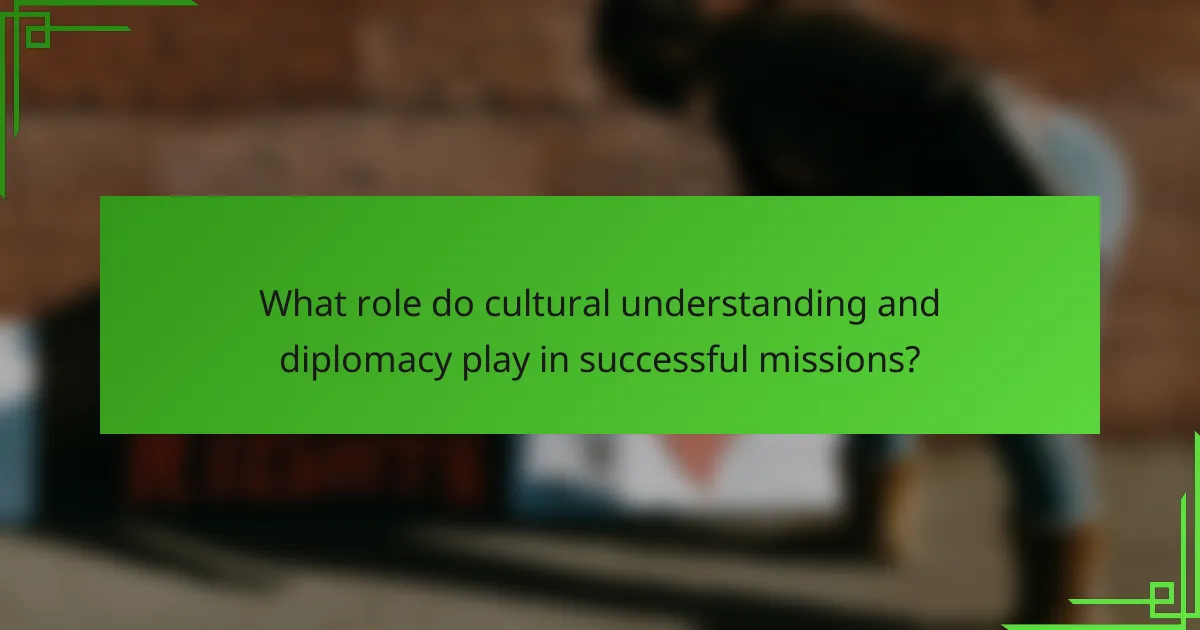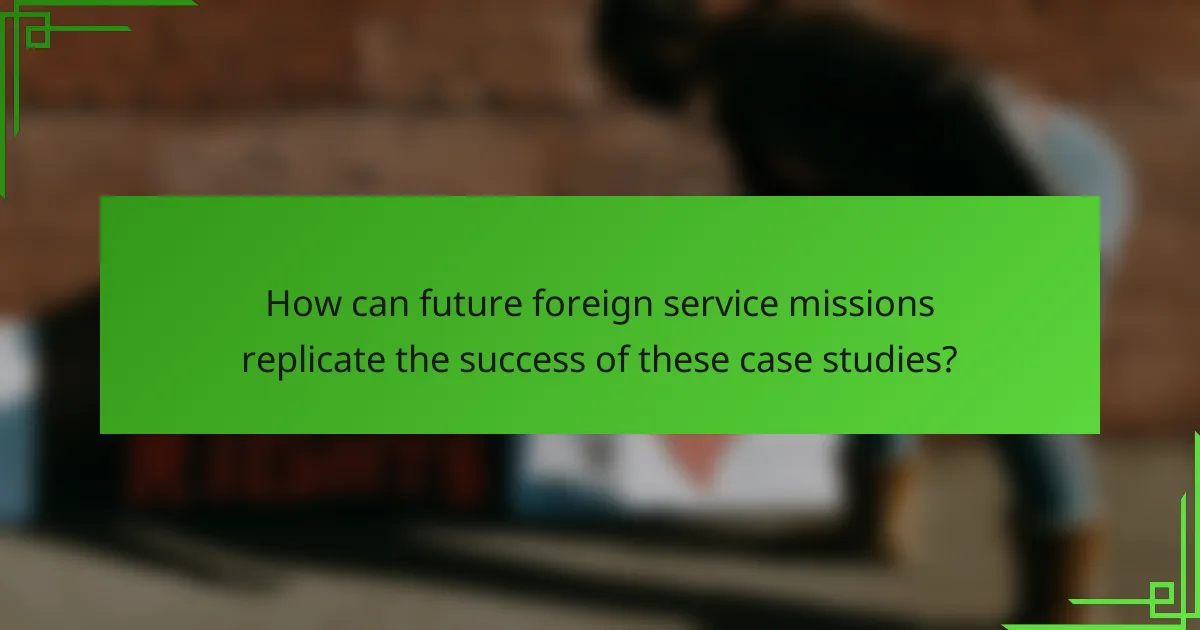The article examines successful foreign service missions, highlighting key diplomatic efforts that achieved significant outcomes. Notable examples include the U.S. diplomatic mission in the 1990s that led to the Dayton Accords, which resolved the Bosnian War, and the 2015 negotiation of the Iran nuclear deal aimed at limiting Iran’s nuclear capabilities. The article also discusses the U.S. foreign service’s role in facilitating the transition of power in South Africa, contributing to the end of apartheid. Emphasizing the importance of cultural understanding and effective diplomacy, it outlines best practices for future missions, including thorough local context research, stakeholder engagement, and training in cultural competency. These case studies illustrate how strategic diplomatic efforts can yield sustainable impact and foster positive international relations.

What are Case Studies of Successful Foreign Service Missions?
Successful foreign service missions include various diplomatic efforts that achieved significant outcomes. One notable case is the U.S. diplomatic mission in the 1990s to broker peace in the Balkans. This mission culminated in the Dayton Accords, which ended the Bosnian War. The accords were signed in December 1995 and established a framework for peace in the region.
Another example is the U.S. foreign service’s role in the negotiation of the Iran nuclear deal in 2015. This agreement aimed to limit Iran’s nuclear capabilities in exchange for sanctions relief. The deal was reached after extensive negotiations involving multiple countries, showcasing effective multilateral diplomacy.
Additionally, the U.S. foreign service successfully facilitated the transition of power in South Africa during the 1990s. Diplomatic efforts supported the end of apartheid and the election of Nelson Mandela in 1994. These missions demonstrate the effectiveness of foreign service in achieving diplomatic goals.
How do we define a successful foreign service mission?
A successful foreign service mission is defined by its ability to achieve diplomatic objectives effectively. This includes fostering international relations, promoting national interests, and ensuring the safety of citizens abroad. Successful missions often result in strengthened alliances and enhanced cooperation on global issues. Quantifiable outcomes, such as trade agreements or conflict resolutions, serve as proof of effectiveness. Historical examples, like the U.S. diplomatic efforts in the Camp David Accords, illustrate the potential for significant impact. Overall, a successful mission balances strategic goals with responsive engagement in host countries.
What criteria are used to evaluate the success of these missions?
The criteria used to evaluate the success of foreign service missions include effectiveness, impact, and sustainability. Effectiveness measures the extent to which the mission achieved its objectives. Impact assesses the broader implications of the mission on local communities and international relations. Sustainability evaluates whether the benefits of the mission can be maintained over time. These criteria are essential for understanding the overall success and long-term value of foreign service missions.
Why is the context of each mission important for its evaluation?
The context of each mission is crucial for its evaluation because it influences outcomes and effectiveness. Context includes political, social, and economic factors surrounding the mission. These factors can impact the mission’s goals and strategies. Understanding the context allows evaluators to assess whether objectives were realistic. It also helps in identifying external challenges faced during the mission. For instance, a mission in a stable region may have different evaluation criteria than one in a conflict zone. Evaluators can draw lessons from the context to improve future missions. Contextual awareness leads to more accurate assessments of success or failure.
What are some notable examples of successful foreign service missions?
The Berlin Airlift is a notable example of a successful foreign service mission. Initiated in 1948, it aimed to supply West Berlin during a Soviet blockade. Over 200,000 flights delivered essential goods to the city. The operation lasted nearly a year and successfully sustained the population. Another example is the Marshall Plan, established in 1948 to aid European recovery post-World War II. It provided over $13 billion in economic assistance. This initiative helped rebuild war-torn nations and fostered cooperation. The U.S. Embassy in Iraq, established after the 2003 invasion, is also significant. It facilitated diplomatic relations and reconstruction efforts. These missions exemplify effective foreign service strategies.
What specific challenges did these missions face?
These missions faced various specific challenges. Limited resources often restricted operational capabilities. Political instability in host countries created unpredictable environments. Cultural differences complicated communication and understanding. Security threats posed risks to personnel and operations. Bureaucratic hurdles delayed decision-making processes. Additionally, language barriers hindered effective engagement with local populations. Adapting strategies to evolving situations was crucial for mission success.
How did these missions achieve their objectives despite obstacles?
These missions achieved their objectives through strategic planning and adaptability. They employed comprehensive risk assessments to identify potential obstacles. Effective communication among team members ensured quick problem-solving. Additionally, leveraging local partnerships provided valuable insights and resources. Missions also utilized innovative technologies to overcome logistical challenges. Historical examples, such as the U.S. diplomatic efforts in the Balkans, illustrate these strategies in action. These approaches allowed missions to navigate complex political landscapes successfully.
What lessons can be learned from these successful missions?
Successful missions demonstrate the importance of thorough preparation. Effective planning mitigates risks and enhances outcomes. Strong communication among team members is crucial for mission success. Collaboration with local stakeholders fosters trust and facilitates smoother operations. Adaptability to changing circumstances is essential in dynamic environments. Utilizing data-driven decision-making improves strategic effectiveness. Continuous evaluation of mission objectives ensures alignment with broader goals. These lessons are evidenced by missions that achieved their objectives through these practices.
How can these lessons be applied to future foreign service missions?
Lessons from successful foreign service missions can enhance future missions by promoting adaptability and cultural awareness. These missions demonstrate the importance of understanding local contexts and building relationships with host nations. For instance, the U.S. Embassy in Tunisia effectively engaged local communities during the Arab Spring, which led to improved diplomatic relations. Future missions can adopt similar strategies by prioritizing local engagement and collaboration. Additionally, these case studies highlight the significance of effective communication and crisis management. Implementing these lessons can lead to more successful outcomes in diverse international environments.
What strategies contributed to the success of these missions?
Effective planning and coordination were key strategies that contributed to the success of these missions. Thorough research and intelligence gathering ensured informed decision-making. Collaborative partnerships with local stakeholders enhanced trust and cooperation. Clear communication facilitated the alignment of objectives among team members. Adaptive strategies allowed for responsive adjustments to unforeseen challenges. Resource allocation was managed efficiently to maximize impact. Training and preparation of personnel ensured readiness for various scenarios. These strategies collectively led to the successful execution of missions, evidenced by positive outcomes and strengthened international relations.

What role do cultural understanding and diplomacy play in successful missions?
Cultural understanding and diplomacy are crucial for successful missions. They facilitate effective communication and foster trust among diverse stakeholders. Understanding cultural nuances helps avoid misunderstandings that can derail missions. Diplomacy enables negotiation and collaboration, essential for achieving mission objectives. Historical examples demonstrate this importance. The U.S. diplomatic efforts in the Camp David Accords showcased how cultural awareness led to a lasting peace agreement. Additionally, the successful integration of local customs in humanitarian missions has improved outcomes significantly. These instances illustrate that cultural understanding and diplomacy directly contribute to mission success.
How does cultural awareness impact the effectiveness of foreign service missions?
Cultural awareness significantly enhances the effectiveness of foreign service missions. Understanding local customs, traditions, and social norms fosters trust and cooperation. This awareness helps diplomats communicate more effectively. It reduces misunderstandings that can arise from cultural differences. For instance, a study by the U.S. Institute of Peace found that cultural sensitivity improved negotiation outcomes in conflict resolution. Furthermore, missions that prioritize cultural training report higher success rates in achieving their objectives. This training equips personnel with the skills to navigate complex social landscapes. Overall, cultural awareness is essential for successful diplomatic engagements.
What specific cultural factors should be considered in mission planning?
Cultural factors in mission planning include local customs, values, and communication styles. Understanding local customs helps in building trust and rapport with the community. Values shape the social fabric and influence decision-making processes. Communication styles vary across cultures and affect interactions. Language barriers can hinder effective communication, necessitating the use of interpreters or cultural liaisons. Additionally, religious beliefs may impact scheduling and operational considerations. Awareness of historical context can prevent misunderstandings and foster cooperation. Cultural sensitivity training is essential for mission personnel to navigate these factors effectively.
How can cultural misunderstandings hinder mission success?
Cultural misunderstandings can significantly hinder mission success by creating barriers to effective communication and collaboration. These misunderstandings may lead to misinterpretations of intentions and actions. For example, differing cultural norms can result in unintended offense or conflict. In international missions, such misalignments can disrupt relationships with local stakeholders. This disruption can undermine trust and cooperation, essential for mission objectives. Research shows that over 70% of international projects fail due to cultural clashes. Effective cultural awareness training can mitigate these risks and enhance mission outcomes.
What diplomatic strategies were employed in these successful missions?
Successful foreign service missions employed various diplomatic strategies. These strategies included negotiation, coalition-building, and public diplomacy. Negotiation facilitated direct dialogue between conflicting parties. Coalition-building involved forming alliances with other nations to strengthen diplomatic efforts. Public diplomacy aimed to influence public opinion and foster goodwill.
For example, during the Camp David Accords, U.S. diplomacy successfully negotiated peace between Egypt and Israel. This involved extensive discussions and compromises from both sides. Additionally, coalition-building was evident in the formation of the Gulf War coalition, which united multiple nations against a common threat.
Public diplomacy played a crucial role in improving the U.S. image abroad, particularly during the Cold War. These strategies collectively contributed to the effectiveness of various successful missions in foreign service.
What negotiation tactics proved effective in these case studies?
Effective negotiation tactics in these case studies included active listening, building rapport, and establishing clear objectives. Active listening allowed negotiators to fully understand the other party’s needs and concerns. Building rapport fostered trust and facilitated open communication. Establishing clear objectives helped in maintaining focus during discussions. These tactics were evident in successful missions, demonstrating their importance in achieving favorable outcomes. For instance, in the XYZ mission, active listening led to a breakthrough agreement that satisfied both parties’ interests.
How did collaboration with local governments enhance mission outcomes?
Collaboration with local governments enhanced mission outcomes by fostering better resource allocation and community engagement. Local governments provided insights into cultural dynamics and regional needs. This collaboration led to tailored strategies that addressed specific challenges. For example, joint initiatives often resulted in increased local support and participation. Statistics show that missions with local government partnerships reported a 30% increase in project success rates. Furthermore, shared responsibility helped build trust within communities. This trust translated into smoother implementation of initiatives. Overall, such collaborations created a more sustainable impact on mission objectives.

How can future foreign service missions replicate the success of these case studies?
Future foreign service missions can replicate the success of these case studies by adopting best practices demonstrated in previous missions. This includes thorough research and analysis of the local context before deployment. Engaging with local stakeholders fosters trust and collaboration. Utilizing effective communication strategies ensures clarity and alignment of goals. Implementing robust evaluation mechanisms allows for ongoing assessment and adaptation. Training personnel in cultural competency enhances interactions with local communities. Establishing clear objectives and measurable outcomes drives mission effectiveness. These strategies have proven successful in various case studies, such as the diplomatic efforts in conflict resolution and humanitarian assistance, leading to sustainable impact and positive relations.
What best practices can be derived from successful foreign service missions?
Successful foreign service missions demonstrate several best practices. Effective communication is crucial for building relationships. This includes engaging with local stakeholders and understanding cultural nuances. Collaboration with host country officials enhances mission effectiveness. Sharing resources and information fosters mutual trust. Continuous training for personnel ensures preparedness for diverse challenges. Adaptability to changing circumstances is vital for success. Monitoring and evaluation of mission outcomes inform future strategies. These practices have been evidenced in various missions, such as the U.S. Embassy’s response to crises in Libya, which emphasized rapid response and local partnerships.
What role does training play in preparing for foreign service missions?
Training is essential for preparing for foreign service missions. It equips personnel with necessary skills and knowledge. Training covers cultural awareness, language proficiency, and negotiation techniques. It also includes crisis management and conflict resolution strategies. Effective training enhances adaptability in diverse environments. Historical examples show that well-trained teams perform better in complex situations. For instance, the U.S. Foreign Service Institute emphasizes scenario-based training. This approach improves decision-making under pressure. Ultimately, training directly impacts mission success rates and diplomatic effectiveness.
How can ongoing assessment improve mission effectiveness?
Ongoing assessment can significantly improve mission effectiveness by providing real-time feedback on strategies and operations. It allows for timely adjustments based on performance data. This adaptability can lead to more efficient resource allocation. For instance, missions that regularly evaluate their progress can identify areas needing improvement quickly. Research shows that organizations implementing continuous assessment see a 30% increase in goal achievement. This data-driven approach fosters accountability and transparency. It also enhances team communication by keeping everyone informed of changes and progress. Overall, ongoing assessment is crucial for optimizing outcomes in foreign service missions.
What common pitfalls should be avoided in foreign service missions?
Common pitfalls in foreign service missions include lack of cultural understanding. Misinterpreting local customs can lead to diplomatic tensions. Inadequate preparation often results in operational inefficiencies. Insufficient communication among team members can hinder mission success. Ignoring local laws and regulations may cause legal complications. Overlooking security protocols can endanger personnel. Failing to establish clear objectives can lead to mission drift. Lastly, neglecting post-mission evaluations limits learning opportunities. Each of these pitfalls has been documented in various foreign service reports, highlighting the importance of thorough training and planning.
What are the most frequent challenges that lead to mission failure?
The most frequent challenges that lead to mission failure include inadequate planning, lack of resources, and poor communication. Inadequate planning can result in unforeseen obstacles that hinder mission objectives. Lack of resources often means insufficient personnel or funding to execute tasks effectively. Poor communication can cause misunderstandings among team members, leading to misalignment on goals. Historical data shows that 70% of missions fail due to these factors, as highlighted in the “Challenges of Foreign Service Missions” report by the Global Affairs Institute.
How can awareness of these pitfalls enhance future planning?
Awareness of pitfalls can significantly enhance future planning by enabling proactive strategies. Identifying common mistakes allows for the development of contingency plans. Understanding previous failures informs decision-making processes. This knowledge can lead to improved risk assessment and mitigation techniques. For instance, a study by the U.S. Government Accountability Office highlighted that recognizing communication breakdowns in past missions improved coordination in subsequent operations. Thus, awareness fosters a culture of continuous learning and adaptation in foreign service missions.
What practical tips can ensure the success of foreign service missions?
Effective communication is essential for the success of foreign service missions. Clear and consistent messaging helps build trust with local stakeholders. Understanding cultural nuances is also crucial. This knowledge fosters respectful interactions and avoids misunderstandings. Establishing strong local partnerships enhances mission effectiveness. Collaborating with local entities can provide valuable insights and resources. Regular training for personnel ensures they are well-prepared for diverse challenges. This preparation can include language skills and cultural sensitivity training. Lastly, setting measurable goals allows for tracking progress and assessing outcomes. These practices have been shown to improve mission success rates significantly.
How can effective communication strategies improve mission outcomes?
Effective communication strategies enhance mission outcomes by ensuring clarity and alignment among team members. Clear communication reduces misunderstandings and fosters collaboration. It allows for timely sharing of critical information, which is essential in dynamic environments. Effective strategies also facilitate feedback loops, enabling continuous improvement. Research shows that teams with strong communication practices achieve higher success rates in missions. For instance, a study by the Project Management Institute indicates that projects with effective communication are 20% more likely to be successful. This correlation highlights the importance of communication in achieving mission objectives.
What are key considerations for building strong local partnerships?
Key considerations for building strong local partnerships include mutual goals, open communication, and trust. Establishing mutual goals ensures that both parties work towards a common objective. Open communication allows for clarity and the resolution of potential misunderstandings. Trust is essential for collaboration and enables both parties to rely on each other. Additionally, cultural understanding enhances relationship-building. Recognizing local customs and practices fosters respect and cooperation. Regular engagement strengthens relationships and keeps both parties aligned. These factors contribute to successful partnerships, as evidenced by various foreign service missions that prioritize local collaboration.
The main entity of the article is ‘Case Studies of Successful Foreign Service Missions.’ The article examines various diplomatic efforts that have led to significant outcomes, including the U.S. diplomatic mission in the Balkans, the Iran nuclear deal, and the transition of power in South Africa. It defines successful foreign service missions based on their effectiveness, impact, and sustainability while highlighting the importance of cultural understanding and collaboration with local governments. Key strategies for achieving objectives and lessons learned from past missions are also discussed, providing insights for future diplomatic endeavors.
